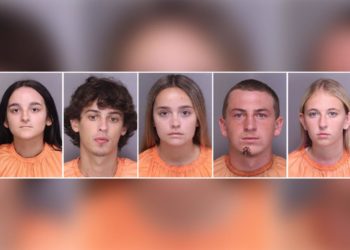Imagine sitting in a cafe or a foxhole or a government office in Ukraine on Friday, watching those first scenes in Anchorage.
There was Russian President Vladimir Putin, the man who had twice ordered an invasion of their country and been indicted for war crimes, taking his first steps on American soil in nearly a decade…on a red carpet.
There were the two leaders—Putin and President Donald Trump—shaking hands and grinning as American warplanes, including a B-2 bomber, flew over them in formation. And then they were ducking into the “Beast,” the U.S. presidential limousine, for a private ride to the summit venue.
It was a welcome tailored for a close friend, not a war criminal, and it had to have looked to Ukrainians like their worst nightmare — a total sellout. Surely the Russian dictator had already won.
Read more: Trump Calls for Full Deal to End Ukraine War in Major Shift Following Putin Summit
But if those were the tea leaves, the early signs, what followed (or didn’t follow) will have soothed anxieties—somewhat. The talks ended hours earlier than expected. There was no joint press conference. And while both leaders tried to put a positive public spin on their talks, there was, as Trump himself put it, “no deal.”
“Many points were agreed to, and there are just a very few that are left,” Trump said, but the rosy, feel-good nature of the arrival ceremony was gone. “There’s no deal until there’s a deal.”
For his part, Putin had shown no willingness to shift course, reverting to complaints about “fundamental threats to our security” and “the need to eliminate all of the primary causes of the conflict,” which have been code since February 2022 for Putin’s idea that his invasion was justified by grievances and warped claims about Russia’s rightful place in the world.
Who won?
So who “won” at Anchorage? We may not know for some time. But the day brought some surprises.
Putin came to Alaska seeking to deepen a divide between the U.S. and its allies. He brought top economic aides to the summit, hoping to discuss a broader U.S.-Russia agenda, including a normalization of diplomatic and business relations. But that broader dialogue never happened, and Trump said it wouldn’t happen “until we get the war settled.”
That said, Putin could claim three major “wins” after his Alaska visit.
The first was an agreement from Trump to abandon ceasefire talks and move directly to negotiations for a broader settlement. That mirrored a longstanding Putin demand and represented a 180-degree turn for Trump, who said this week that a ceasefire had to come first – and that Putin would face “severe consequences” if he didn’t agree to one.
The second win for Putin was what didn’t happen. He left Anchorage facing no “consequences”—none of the secondary sanctions Trump had threatened, and no new deadlines for a ceasefire.
Perhaps the most important “win” was the glow of that red-carpet welcome. It was a remarkable form of global rehabilitation for the Russian leader. Russian state TV aired glowing reports of the arrival ceremony. Dmitri Medvedev, the former Russian president who has issued regular anti-U.S. diatribes over the years, called Friday’s summit “calm, without ultimatums and threats,” and said that Trump had “abandoned the escalation of pressure on Russia.”
When ‘no deal’ is good news
For Ukraine, meanwhile, “no deal” wasn’t a bad outcome.
The runup to Anchorage had featured an almost nonstop Ukrainian diplomatic effort to ensure that Trump wouldn’t sell out their country to Putin. Trump and Ukrainian President Volodymyr Zelensky joined a remote summit of European leaders on Wednesday that was chaired by German Chancellor Friedrich Merz, after which Merz said, cryptically, that Trump had “largely shared” the Europeans’ views. That left everyone wondering what was meant by “largely”—and Anchorage brought some answers. Trump abandoned the Europeans’ ceasefire-first approach, but remained on board with another core principle: Ukraine must be heard.
The good news for Kyiv was that there was no forced “land swap” or other Trump-Putin plan announced in Alaska. Trump called Zelensky on his way home – a conversation that the Ukrainian leader called “long and substantive” – and invited him to the White House on Monday. That was a positive development as well.
As for Trump himself, the obvious takeaway is that he didn’t get the ceasefire he was expecting. Beyond that, it’s hard to say, in part because his administration has yet to articulate a policy or strategy towards Ukraine or Russia beyond the desire for peace and a warming of U.S.-Russia relations. “The meeting was a 10 in the sense that we got along great,” Trump told Sean Hannity after the summit. He didn’t offer a grade for the substance.
Ukrainians and their supporters will still worry that Trump wants a grand global peace deal – and that he has no qualms about coddling a war criminal to get one. To date, the man who promised repeatedly to end the wars in Gaza and Ukraine (the latter “in 24 hours”) has nothing to show for his efforts, despite a series of concessions to Moscow.
Ukrainian anxieties weren’t soothed in the runup to Anchorage, when Trump went out of his way to hail Russia’s victories against Napoleon and Hitler, and then called and praised President Alexander Lukashenko of Belarus, perhaps Putin’s closest ally.
But in the end, when the “deal or no deal” moment came in Anchorage, Trump said no. At least for now. Perhaps the exhortations of the Ukrainian and other European leaders had resonated. Or perhaps this was a reprise of Trump’s rare diatribe last month: “We get a lot of bullshit thrown at us by Putin, if you want to know the truth,” he said then. Had Trump called “BS” on Putin in Alaska? Doubtful. But we don’t yet know.
What comes next?
Monday’s Zelensky White House visit – and the surrounding atmospherics and post-meeting statements – will say a lot about the way forward. Trump may yet wash his hands of the war, if the two leaders – Putin especially – frustrate his efforts. If Trump chooses to stay engaged, he may at some point have to inflict pain on Putin, or at least the prospect of pain, to win concessions. Policymakers and analysts on both sides of the Atlantic have urged a range of levers the White House might use—among them, signing the Senate’s Russia sanctions bill, reopening the weapons spigot to Ukraine and removing targeting restrictions on Ukraine’s use of U.S.-supplied weapons.
To date, Trump has shown no inclination to take such steps. The question may be just how badly he wants to get credit for ending the war.
It may seem strange – or insane, even – to speak about a Nobel Peace Prize for Donald Trump, especially in the wake of a summit that achieved no peace. But it’s worth noting that Trump has long been “obsessed” with the prize, as Le Monde wrote recently, and it’s not far-fetched to imagine that his obsession will persuade him to keep pushing for a Ukraine agreement. A half dozen countries have recognized this and recommended a Nobel for Trump as a supreme form of flattery – Israel’s Prime Minister Benjamin Netanyahu added the flourish of hand-delivering his nomination to the President. Just last month, Trump himself cold-called the Norwegian finance minister last month to discuss the prize, the newspaper Dagens Næringsliv reported.
Earlier this year, when the idea of a Trump-Putin summit was first broached, I asked several former U.S. diplomats and intelligence officials how they might counsel the president before a Putin summit.
Read more: Why Trump’s Summit in Alaska Cannot End Putin’s War in Ukraine
I thought on Friday about one of those conversations—with John McLaughlin, a former acting director of the CIA, who told me that while he generally supported the idea of American presidents meeting with adversaries to advance the cause of peace, Putin represented “a special case.”
“He’s not just an adversary,” McLaughlin said. “We’re talking about this as though Putin’s just another senior bad guy we may meet with, but we really have to say, at the end of the day, he broke all the rules. He’s an indicted war criminal. He’s not the normal bad leader — he’s a pariah.”
McLaughlin offered several suggestions: that Trump make clear demands of the Russian leader in exchange for the “gift” of a summit; that he go in with total alignment with our NATO allies; above all, he counseled the president to “know in advance what you want at the end”.
“Putin will not come in improvisationally,” McLaughlin said. “So Trump would have to know, very clearly, ‘what do I want at the end of this?’”
On the day after the summit, it’s hard to avoid the conclusion that Trump came to Anchorage “improvisationally,” to use McLaughlin’s word. We will know soon whether his approach yielded anything. The fear is that history will judge the Alaska meeting much as it has judged Trump’s summits in 2018 and 2019 with the North Korean dictator Kim Jong Un—heavy on theatrics and promises and warm words for a brutal dictator, and beyond all that, no progress at all.
The post Putin Got Three Major Wins From Trump in Anchorage, But the Talks Aren’t Over appeared first on TIME.




